Can someone help?
A metal works company is creating alloy Z by combining alloy X and alloy Y in a specific ratio. Alloy X is 25% copper by weight and alloy Y is 65% copper by weight.
identify the percent of alloy Z that is composed of alloy X and the percent of alloy Z that is copper by weight. These percents must be consistent with each other and with the conditions stated above.
Alloy X (% of Alloy Z) Copper (% of Alloy Z) Percent
25%
35%
50%
60%
65%
75%
MGMAT 5th Edition - 2 part question
This topic has expert replies
-
adigmat2013
- Junior | Next Rank: 30 Posts
- Posts: 14
- Joined: Sun Jul 28, 2013 5:36 am
-
adigmat2013
- Junior | Next Rank: 30 Posts
- Posts: 14
- Joined: Sun Jul 28, 2013 5:36 am
The percentages have come under the wrong column. Basically, there are 3 columns ' Alloy X (% of Alloy Z)', 'Copper (% of Alloy Z)' and 'Percent' and the percentages are under the 'Percent' column. We need to choose the correct percentage from the given options.
GMAT/MBA Expert
- ceilidh.erickson
- GMAT Instructor
- Posts: 2095
- Joined: Tue Dec 04, 2012 3:22 pm
- Thanked: 1443 times
- Followed by:247 members
Ceilidh Erickson
EdM in Mind, Brain, and Education
Harvard Graduate School of Education
EdM in Mind, Brain, and Education
Harvard Graduate School of Education
GMAT/MBA Expert
- ceilidh.erickson
- GMAT Instructor
- Posts: 2095
- Joined: Tue Dec 04, 2012 3:22 pm
- Thanked: 1443 times
- Followed by:247 members
This is a weighted average question. We're being asked: which is a possible combination of answer choices for the percentage of alloy X within alloy Z, and of copper within alloy Z?
Students often get these questions mixed up, because we have two different kinds of percentages to deal with.
- if the overall mixture were made up of 100% of alloy X, it would have 25% copper
- if the overall mixture were 0% alloy X (100% alloy Y), it would have 65% copper
We can represent this kind of weighted average with a scale (or see-saw):
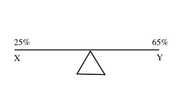

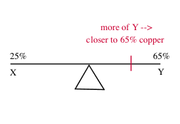
Based on the above, it would be impossible for the amount of copper in alloy Z to be 25% unless the amount of alloy X was 100% (not an option), or to be 65% unless the amount of X was 0% (also not an option).
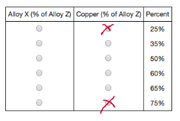
Now, test some of the other answer choices:
- what if we has 50% of alloy X, 50% of alloy Y? Then we'd be exactly halfway between 25 and 65% copper: 45%. Since that's not an answer option, we can't have 50% of X.
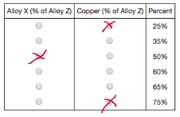
- If we had 25% of X and 75% of Y, we'd have 0.25(25) + 0.75(65) = 55% copper. Not an answer option.
- If we had 35% of X and 65% of Y, we'd have 0.35(25) + 0.65(65) = 51% - not an option
- If we had 60% of X and 40% of Y, we'd have 0.6(25) + 0.4(65) = 41% - not an option
- If we had 65% of X and 35% of Y, we'd have 0.65(25) + 0.35(65) = 39% - not an option
- If we had 75% of X and 25% of Y, we'd have 0.75(25) + 0.25(65) = 35% - BINGO!
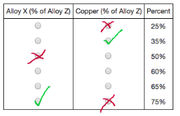
Students often get these questions mixed up, because we have two different kinds of percentages to deal with.
- if the overall mixture were made up of 100% of alloy X, it would have 25% copper
- if the overall mixture were 0% alloy X (100% alloy Y), it would have 65% copper
We can represent this kind of weighted average with a scale (or see-saw):



Based on the above, it would be impossible for the amount of copper in alloy Z to be 25% unless the amount of alloy X was 100% (not an option), or to be 65% unless the amount of X was 0% (also not an option).

Now, test some of the other answer choices:
- what if we has 50% of alloy X, 50% of alloy Y? Then we'd be exactly halfway between 25 and 65% copper: 45%. Since that's not an answer option, we can't have 50% of X.

- If we had 25% of X and 75% of Y, we'd have 0.25(25) + 0.75(65) = 55% copper. Not an answer option.
- If we had 35% of X and 65% of Y, we'd have 0.35(25) + 0.65(65) = 51% - not an option
- If we had 60% of X and 40% of Y, we'd have 0.6(25) + 0.4(65) = 41% - not an option
- If we had 65% of X and 35% of Y, we'd have 0.65(25) + 0.35(65) = 39% - not an option
- If we had 75% of X and 25% of Y, we'd have 0.75(25) + 0.25(65) = 35% - BINGO!

Ceilidh Erickson
EdM in Mind, Brain, and Education
Harvard Graduate School of Education
EdM in Mind, Brain, and Education
Harvard Graduate School of Education
GMAT/MBA Expert
- ceilidh.erickson
- GMAT Instructor
- Posts: 2095
- Joined: Tue Dec 04, 2012 3:22 pm
- Thanked: 1443 times
- Followed by:247 members
One shortcut would be to recognize that weighted averages are PROPORTIONAL.
For example, if you had 5 grams of mixture A that was 20% alcohol, and 10 grams of mixture B that was 50% alcohol, you would have a 1:2 ratio of A:B. The distance between your extreme points (20% and 50%) and the actual amount will be in the same ratio 1:2. Since the total range of possible alcohol percentages is 30 (50 - 20), then the percentage of the total mixture must be 40% (20 away from A's amount, 10 away from B's amount).
In the problem above, you might recognize that the total range is 40 (65% - 25%). Therefore, you might want to start with 25% and 75% for the percentage of alloy X, as that would correspond nicely to a 1:3 or 3:1 ratio out of a total of 4.
For more on weighted averages, see:
https://www.manhattanprep.com/gmat/blog ... -pen-down/
https://www.manhattanprep.com/gmat/blog ... -problems/
https://www.manhattanprep.com/gmat/blog ... lems-easy/
https://www.manhattanprep.com/gmat/blog ... -the-gmat/
For example, if you had 5 grams of mixture A that was 20% alcohol, and 10 grams of mixture B that was 50% alcohol, you would have a 1:2 ratio of A:B. The distance between your extreme points (20% and 50%) and the actual amount will be in the same ratio 1:2. Since the total range of possible alcohol percentages is 30 (50 - 20), then the percentage of the total mixture must be 40% (20 away from A's amount, 10 away from B's amount).
In the problem above, you might recognize that the total range is 40 (65% - 25%). Therefore, you might want to start with 25% and 75% for the percentage of alloy X, as that would correspond nicely to a 1:3 or 3:1 ratio out of a total of 4.
For more on weighted averages, see:
https://www.manhattanprep.com/gmat/blog ... -pen-down/
https://www.manhattanprep.com/gmat/blog ... -problems/
https://www.manhattanprep.com/gmat/blog ... lems-easy/
https://www.manhattanprep.com/gmat/blog ... -the-gmat/
Ceilidh Erickson
EdM in Mind, Brain, and Education
Harvard Graduate School of Education
EdM in Mind, Brain, and Education
Harvard Graduate School of Education




















